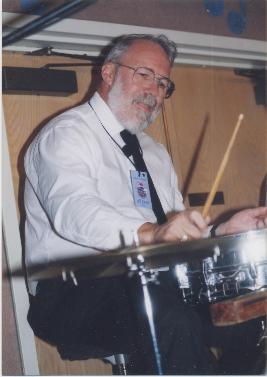FRANCISCO OCTOBER 1954 (Acrobat Music ADDCD3070)
CD1 Playing time: 59 mins. 48 secs.
2nd October 1954 Without You for an Inspiration (Theme); I Found a New Baby;
Hagar’s Blues; Washington and Lee Swing; Lady Be Good*; Sweet Georgia Brown.
16th October 1954 Without You for an Inspiration (Theme); Wolverine Blues;
Muskrat Ramble; Black and Blue; Going to Sit Right Down and Write Myself a
Letter*; St. Louis Blues.
CD2 Playing time: 59 mins. 58 secs.
23rd October 1954 Without You for an Inspiration (Theme); Ballin’ the Jack; St.
James Infirmary Blues; Indiana; Boogie*; I Found a New Baby; Shine.
30th October 1954 Without You for an Inspiration (Theme); Clarinet Marmalade;
Darktown Strutters’ Ball; Bolden’s Blues; St. Louis Blues*; Dippermouth Blues;
Milenburg Joys.
Personnel: Edward ‘Kid’ Ory, trombone; Alvin Alcorn, trumpet; George Probert,
soprano sax [incorrectly listed as clarinet]; Don Ewell, piano; Ed Garland, bass;
Minor ‘Ram’ Hall, drums. Jesse ‘Tiny’ Crump, intermission piano*.
The 1950’s was a kind of golden age for traditional jazz in San Francisco. In that
decade several clubs there featured such music, including the Tin Angel, the Club
Hangover, the Italian Village, the Sail ‘N [sic], and towards the end of the period
Kid Ory’s own club, On the Levee.
During that time Ory’s band appeared at Club Hangover frequently, and in one
such residency in 1954, broadcast on CBS several times, recordings of four of which
are on this CD. (Note: the last two sessions on the CD were previously released on
LP on the Dawn Club label, the date of the first being given there incorrectly as Oct.
10th.) This is the first time these broadcasts have appeared on CD, but they did not
constitute Ory’s radio debut. The band made a broadcast in 1923, of which Ory later
claimed, “I guess we were the first New Orleans style band to make a radio
broadcast.” (Another first was the Ory band’s being the first African-American jazz
band from New Orleans to make jazz recordings on the West Coast.)
This CD exemplifies Ory’s “tailgate” style, which was quite definitive with its
smears and ascending and descending glissandi, muted growls, and fatness of tone.
Like some other leaders, Ory could mold his side men into a unit with his stamp,
and the band’s “sound” is a clearly recognizable one, regardless of its personnel.
Earlier versions of the band gave much more scope to the ensemble playing that is
so characteristic of the New Orleans style subscribed to then by the leader, Kid Ory,
a New Orleans native. These earlier Ory bands were comprised largely of fellow
New Orleanians, and they, too, were accustomed to collective improvisation. The
personnel in this later band, however, lean more to the soloing that had been
introduced some time before by that other New Orleanian, Louis Armstrong.
Despite the emphasis on solos, the band is never uninteresting, even though it most
often embraces the “sandwich” pattern of one or two introductory ensembles/string
of solos/one or two ensembles out, which can be so deadly; and Ory flirts rather
dangerously with monotony in having the order of solos seldom deviate from that
of reed, followed by trumpet, followed by trombone (if Ory takes a solo), and then
by piano. However, he keeps a firm grip on the proceedings, not allowing more
than one chorus for each soloist.
In addition, head arrangements have been worked out; so frequently there are
interesting riffs inserted, such as the Charleston one behind Alcorn’s solo in Sweet
Georgia Brown or those during the breaks on the coda of Ballin’ the Jack that are
clearly orchestrated. Also adding to the interest are effects such as the closing
cadenza by Alcorn on St. James Infirmary (ending on high note, which he loved to
do), or the very nice descending harmonized run by the front line on the coda of
Indiana. Another is the rather unusual front line stop time behind the bass solo on
Wolverine Blues.
The variety in tempos further contributes to the group’s appeal. While most tunes
are taken at danceable tempos, there are two or three that are “barn burners,” such
as I Found a New Baby and Clarinet Marmalade. The tempo of the band’s version
of St. Louis Blues is faster than one usually finds with this tune, but it is not
detrimental to the rendition. While speaking of this track, I would point out the
unusual breaks on the latin strain and multiple out-choruses, carefully orchestrated
as to dynamics, possibly in part because they were providing backing for the
announcer’s fairly lengthy sign off. Ory’s manipulation of dynamics, here and
elsewhere, also indicate his control of the group. Finally regarding tempo, I was
surprised at how sedate that of Wolverine Blues was, giving an other-than-usual—
but pleasing—“interpretation” of the tune.
Probably at the behest of Doc Dougherty, the club owner, the announcer gives
much acknowledgement of intermission pianist Crump, who, rather than
performing solo as indicated in the liner notes, is accompanied by Garland on bass
and Hall on drums to form a swing style trio, providing somewhat of a contrast to
the headlining band.
All in all, this double CD is typical Ory fare, and provides an entertaining couple of
hours of good traditional jazz. Acrobat is an English label, so obtaining this item
could be difficult. However, when last I looked, Amazon had a few copies, new and
used, on its web site.
Note: Contrary to what is written in the liner notes and elsewhere, these recordings
came from the archive of the San Francisco Traditional Jazz Foundation (not
Federation). Also the statement that “although he plays clarinet on this set, Probert
was best known as a soprano sax player …” is correct; however, the possible
implication here is misleading. While he does play clarinet on some of selections,
he plays soprano sax on just as many in this set.
|
|


